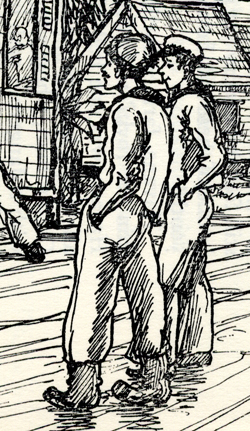Jack Tar: Myth and Reality

Jack Tar was a common English term used to refer to seafarers of the merchant marine and Royal Navy, particularly at the time when the British Empire was at its largest. The public, and seafarers themselves, used the name to identify men who went to sea. There is some dispute among historians about the origin of "Jack," but it was a frequently used generic that identified the mass of common people. The suffix "Tar" is traceable to the 1600s, and became a popular term for a sailor. It probably derived from "tarpaulin," canvas coated with tar to make waterproof clothes. A sailor's waterproof hat was also called a "tarpaulin." Seafarers were stereotyped by their "rolling gait and outlandish outfit and tarry waterproof trousers" (Land 2010, 14).
Period writers often referred to the simplicity of Jack Tar, and when he was represented as a drunk and a womanizer the moral of the story was that he was easy prey for women, publicans and boarding house keepers. Though the social imagery of the port with its bars and brothels can be entertaining, there were teetotalers and family men amongst seafarers. In fact, by 1891, over half of home-trade seafarers and nearly two-fifths of foreign-going men were married (Burton, 1985, 316).
The stereotype of British seafarers is overdrawn. Most men entered the occupation in early adulthood and left before their late thirties. They were men of experience, and they were often the children of sailors, fishermen and coastal mariners. Thus they might bring with them practical experience. Many seamen were literate and could read and understand their contracts. Some could read but could not sign their name. Others appear to be literate because they signed their contract, though an autograph might have been the limit of their abilities (Sager 1989, 158). Canadian and British crews tended to be more literate than other crews. (Alexander 1980, 11). Even seafarers without the ability to read would have a working knowledge of their contractual rights as seafarers.
Men who were firemen, coal trimmers and engineers are less commonly written about than deck crew. By way of redressing this imbalance the experiences of William Finlinson are recounted here. He was born in 1880 in Whitehaven, a port which sustained a vibrant seaborne export trade in coal. But the fortunes of the port waned as larger ones such as Liverpool and Bristol gained prominence in the late-19th century. William's father, Musgrave Finlinson, was a carpenter aboard merchant vessels, and the family moved to Liverpool in 1886 so he could seek better employment. Like many sailors' sons, William went to sea. He first sailed in May 1901, joining the Manchester Merchant as a junior engineer. He continued to sail regularly until his death in 1919 and received his engineer's certificate in April 1904 (Correspondence of Ian Finlinson with Archivist, MHA, Memorial University, September, 2008).
The crews of merchant shipping vessels were multi-national. According to Frederick William Wallace, "seafaring was the profession of a mobile international pool of labor" (Wallace 1924, 186). Crews across the North Atlantic were often comprised of Scandinavians, Greeks, Italians, Germans and Russians. Temporarily drawing men away from their homeland, seafaring attracted those who wanted to see the world and acquire skills. Many joined British vessels for the better pay (Committee on Manning 1896, 397). Foreigners were often hired when crews deserted (160). Many companies hired their officers locally, and more particularly the master (Ommer 1980, 193).
